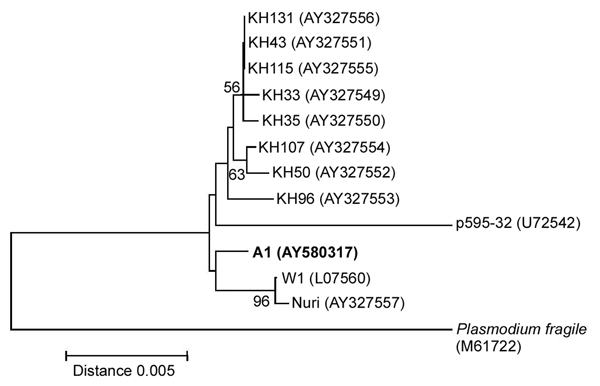 |
| |
||
| |
|||||||||||||||||
|
|||||||||||||||||
|
|||||||||||||||||
| EID
Home | Ahead of Print | Past
Issues | EID Search | Contact
Us | Announcements | Suggested
Citation | Submit Manuscript
Volume 10, Number 12, December 2004 Naturally Acquired Plasmodium knowlesi Malaria in Human, ThailandSomchai Jongwutiwes,*† Chaturong Putaporntip,* Takuya Iwasaki,† Tetsutaro
Sata,‡ and Hiroji Kanbara† |
||
|
|
 |
|
| Back to article | |
|
Figure 2. Neighbor-joining tree based on the asexually transcribed SSU rRNA sequences displaying the phylogenetic position of isolate A1 in this study in relation to other Plasmodium knowlesi isolates (AY327549-AY327556 from humans, and L07560, U72542, and AY327557 from monkeys) and P. fragile (M61722). The tree was constructed with Kimura's two-parameter distance. including transitions and transversions as implemented in the MEGA version 2.1 software. Bootstrap percentages more than 50% based on 1,000 replicates are shown on the branches. |
|
|
|
|
|
EID Home | Top of Page | Ahead-of-Print | Past Issues | Suggested Citation | EID Search | Contact Us | Accessibility | Privacy Policy Notice | CDC Home | CDC Search | Health Topics A-Z |
|
|
This page last reviewed November 22, 2004 |
|
|
Emerging
Infectious Diseases Journal |
|